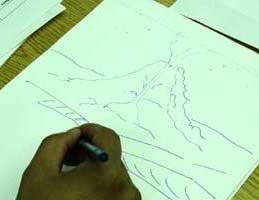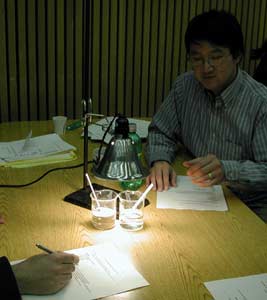|
|
||
Stressing the Nature of Science: Dogs and TurnipsIn this lesson students attempt to assemble a meaningful sentence by successively turning over cards with words on them. The point is made that we change our ideas of what a story may be as we gather more information. In addition, people who have similar information may not agree on its meaning. Science works this way. Activity: Dogs and Turnips |
||
Interactions in the Earth System
|
||
Volcanoes in the Earth SystemTeachers were asked to draw a volcano and then make comparisons to volcanoes around the world. This was followed by excerpts from the video Volcanoes in the Earth System and a discussion as to how such a geospheric phenomenon influences the other spheres.
|
||
Hydrosphere-Atmosphere InteractionsTeachers discussed some of the big ideas involved in the interactions between the hydrosphere and atmosphere. These included the water cycle and weather patterns influenced by differential heating and cooling and El Niņo.
|
||
Uplift of the HimalayasTeachers discussed how the uplift of the Himalayas could impact the other spheres. Uplift of the HimalayasActivity: Ocean
Drilling Core Samples: A Case Study |
||
Additional ResourcesCalifornia Science Content Standards Bay Earth Science Institute website (go to resources) http://passporttoknowledge.com/storm/index_what.htm) Types of volcanoes - courtesy of the US Geological Survey http://vulcan.wr.usgs.gov/Glossary/VolcanoTypes/volcano_types.html and http://vulcan.wr.usgs.gov/Photo/Pictograms/volcano_types.html Water Science
for Schools |
||
| Updated January 5, 2003 Home | What's new | About UCMP | History of Life | Collections | Subway |



 Activity:
Activity: